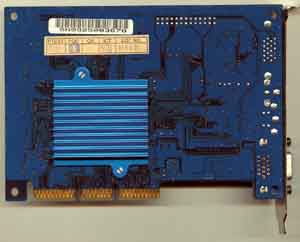Drivers
Once again, the TNT2 Pro is just like the old TNT2 internally, so no new drivers are needed. The currently available 2.08 Detonator reference drivers identify the TNT2 Pro as a standard TNT2, but, be rest assured, this does not slow it down in any way. The 3.xx series from NVIDIA, written primarily to support the GeForce, but compatible with all TNT cards as well, will acknowledge the TNT2 Pro as such.
The Cards
Currently, we only know of two manufacturers using the TNT2 Pro chip on their cards. Gigabyte provided us with a sample of their GA-660 Plus, which is the card we used for the test purposes of this article. Elsa, the other manufacturer, offers the Elsa Erazor III Pro. Elsa was not able to provide a card in time for publication. Notice the Plus and Pro designations on those cards – that’s how you know it’s a TNT2 Pro and not just the standard TNT2. The Gigabyte comes clocked at a default speed of 150/166 and features a turbo jumper that cranks the speed up to 170/180. Elsa cards supposedly run at the NVIDIA recommended 143/166 by default.
Overclocking
The Gigabyte GA-660 Plus was the only TNT2 Pro card we were able to get our hands on in time for this review. The GA-660 Plus is a pretty unique card in a number of ways, which unfortunately skews our overclocking results slightly. Just like the GA-660 standard TNT2 from Gigabyte, the GA-660 Plus features a heatsink and fan on the chip itself as well as a heatsink mounted to the backside of the card.
Further, the memory on the GA-660 Plus is only rated at 6ns or 166 MHz, so the memory is one potential bottleneck. Of course, memory will vary between manufacturers and even between different batches from the same manufacturer. Since the TNT2 Pro is only spec’ed with a memory clock of 166 MHz, don’t expect too many manufacturers to include significantly faster RAM. Some manufacturer could pull a Hercules and take the opportunity to put out the fastest TNT2 on the planet using the TNT2 Pro if higher quality RAM were used.
Nevertheless, we set out to explore the limits of overclocking with the TNT2 Pro. As mentioned above, the GA-660 Plus includes a turbo jumper that sets the speed to 170/180 without the use of any software utilities. The card was completely stable at these speeds, so we pushed further, eventually maxing out the core around 187 MHz with 100% stability. This puts the GA-660 Plus right at the top of the TNT2’s we’ve received as far as overclocking the core goes. As always, overclocking results will vary from card to card and a variety of other factors can influence these results greatly.
The Test
|
Windows 98 SE Test System |
||
|
Hardware |
||
|
CPU(s) |
Intel Pentium III 450 |
AMD K6-2 450 |
| Motherboard | ABIT BH6 | Epox MVP3G-2 |
| Memory |
128MB PC133 Corsair SDRAM |
|
| Hard Drive |
Western Digital 8.4GB AC28400 UDMA/33 |
|
| CDROM |
Kenwood 40X TrueX |
|
| Video Cards |
Matrox Millenium G400 16MB (default
clock - 125/166) |
|
|
Software |
||
|
Operating System |
Windows 98 SE |
|
| Video Drivers |
Matrox Millenium G400 5.25 with
Beta TurboGL |
|
|
Benchmarking Applications |
||
| Gaming |
id Software Quake 3 Test 1.08
(OpenGL) |
|











0 Comments
View All Comments